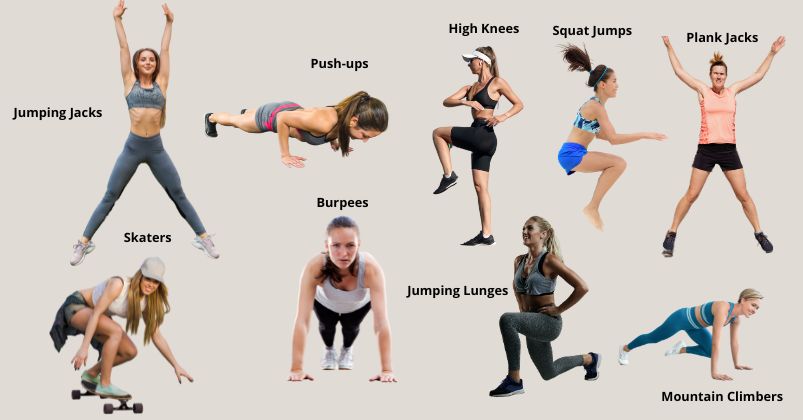Cardio Exercises: The Ultimate Guide to Burning Fat and Improving Heart Health
Cardio exercises are a great way to improve your overall health and fitness. They increase your heart rate and enhance your endurance. Cardio exercises can be performed at home or in a gym and can be tailored to your fitness level. Understanding the benefits of cardio exercises and how to incorporate them into your routine can help you achieve your fitness goals.
Cardio exercises have numerous benefits for your health. They can help you lose weight, improve your cardiovascular health, reduce your risk of chronic diseases, and boost your mood. There are many different types of cardio exercises, including running, cycling, swimming, and dancing. Beginners can start with low-impact exercises like walking or cycling, while advanced exercisers can try high-intensity interval training (HIIT) or circuit training.
Key Takeaways
- Cardio exercises are a type of cardiovascular workout that can improve your overall health and fitness.
- There are many different types of cardio exercises, and they can be tailored to your fitness level.
- The numerous benefits of cardio exercises for your health include weight loss, improved cardiovascular health, reduced risk of chronic diseases, and mood enhancement.
Understanding Cardio
Cardio exercises, also known as cardiovascular exercises, are physical activities that increase your heart rate and breathing rate, causing you to breathe deeply and sweat. These exercises are an essential part of any fitness routine, offering numerous benefits for your health and well-being.
How Cardio Works
Cardio exercises work by increasing your heart rate, which in turn raises the amount of oxygen your body needs. Your lungs work harder to take in more oxygen, which is then transported to your muscles to help them function more efficiently. As you continue with cardio exercises, your body becomes more efficient at using oxygen, improving your endurance and overall fitness level.
Benefits of Cardio
Cardio exercises offer numerous benefits, including improved cardiovascular health, increased endurance, and weight loss. They also help reduce the risk of chronic diseases such as heart disease, diabetes, and high blood pressure. Additionally, cardio exercises can improve your mood, reduce stress, and boost your energy levels.
Types of Cardio Exercises
There are many types of cardio exercises, including running, cycling, swimming, and dancing. The key is to choose an activity that you enjoy and can do regularly. You can also mix up your routine to keep things interesting and challenge your body in different ways.
Monitoring Your Heart Rate
To get the most out of your cardio exercises, it's important to monitor your heart rate. Your target heart rate depends on your age and fitness level, but a general rule of thumb is to aim for 50-85% of your maximum heart rate. You can use a heart rate monitor or simply take your pulse to track your heart rate during exercise.
Building Cardio Endurance
Building cardio endurance takes time and consistency. Start with shorter workouts and gradually increase the duration and intensity over time. It's also important to vary your routine to challenge your body and prevent boredom. With regular cardio exercise, you can improve your endurance and overall fitness level, leading to better health and well-being.
Benefits Of Cardio Exercises

Cardio exercises, also known as aerobic exercises, are physical activities that increase your heart rate and breathing. These exercises can bring a wide range of benefits to your overall health and well-being. Here are some of the benefits of cardio exercises:
Helps With Weight Loss And Burning Fat
Cardio exercises are an effective way to burn calories and lose weight. According to the American Heart Association, adults should aim for at least 150 minutes of moderate-intensity cardio exercises per week to maintain a healthy weight. When you perform cardio exercises, your body burns calories to produce energy, which can help you lose weight and burn fat.
Improves Mental Health
Cardio exercises can also have a positive impact on your mental health. They can help reduce feelings of anxiety and depression and increase your confidence. According to a study published in the Journal of Psychiatric Research, regular aerobic exercises can reduce symptoms of depression and improve overall mood.
Promotes A Healthy Lifestyle
Incorporating cardio exercises into your daily routine can help you maintain a healthy lifestyle. It can improve your overall fitness level, increase your energy, and reduce your risk of chronic diseases such as heart disease, diabetes, and obesity.
Overall, cardio exercises are an excellent way to improve your physical and mental health. They can help you maintain a healthy weight, burn fat, reduce anxiety and depression, and promote a healthy lifestyle. Incorporating cardio exercises into your daily routine can have a significant impact on your overall well-being.
Cardio Exercises For Beginners
If you're new to cardio exercises, it's important to start with low-impact activities that won't put too much strain on your joints. Walking is a great option that can be done indoors or outdoors. Start with a 10-minute walk and gradually increase the duration as you build up your stamina. You can also try jogging in place, which is a low-impact exercise that can be done at home.

Another low-impact option is using a treadmill. This machine allows you to control the speed and incline, making it a great option for beginners. Start with a slow pace and gradually increase the speed and incline as you build up your endurance.
Rowing is another great option that provides a full-body workout. This low-impact exercise can be done on a rowing machine at the gym or at home. Start with a low resistance and gradually increase the intensity as you build up your strength.
Cycling is a low-impact exercise that can be done indoors or outdoors. You can use a stationary bike at the gym or invest in a bike for outdoor rides. Start with a low resistance and gradually increase the intensity as you build up your endurance.
Swimming is a great option for beginners as it is a low-impact exercise that provides a full-body workout. You can swim laps at the pool or try water aerobics classes. Start with a few laps and gradually increase the distance as you build up your endurance.
Hiking is a great way to get outside and enjoy nature while getting a workout. Start with an easy trail and gradually increase the difficulty as you build up your strength and endurance.
Remember to always listen to your body and start with activities that are comfortable for you. Gradually increase the intensity and duration of your workouts as you build up your stamina.
Advanced Cardio Exercises
For those who have been doing cardio exercises for a while and want to take it up a notch, advanced cardio exercises can be a great way to challenge the body and improve cardiovascular fitness.
Intermediate To Advanced Cardio Exercises
Intermediate to advanced cardio exercises are ideal for those who want to increase their heart rate, burn calories, and improve their overall fitness level. Some of these exercises include:
- Running: Running is an excellent way to get your heart rate up and burn calories. It is a high-impact exercise that can be done both indoors and outdoors. Running can be done at a steady pace or can be done as interval training to increase the intensity.
- Jumping Jacks: Jumping jacks are a great way to get your heart rate up and work your entire body. They are low-impact exercises that can be done anywhere.
- Jump Rope: Jump rope is a great way to improve cardiovascular fitness and coordination. It is a high-impact exercise that can be done indoors or outdoors.
- Mountain Climbers: Mountain climbers are a great way to work your core and improve cardiovascular fitness. They are high-intensity exercises that can be done anywhere.
- Burpees: Burpees are a full-body exercise that can be done anywhere. They are a high-intensity exercise that can improve cardiovascular fitness and burn calories.
- Squat Jumps: Squat jumps are a great way to work your legs and improve cardiovascular fitness. They are high-intensity exercises that can be done anywhere.
- Tuck Jumps: Tuck jumps are a great way to work your legs and improve cardiovascular fitness. They are high-intensity exercises that can be done anywhere.
- Box Jumps: Box jumps are a great way to work your legs and improve cardiovascular fitness. They are high-intensity exercises that can be done at the gym or at home.
- High Knees: High knees are a great way to work your legs and improve cardiovascular fitness. They are high-intensity exercises that can be done anywhere.
- Speed Skaters: Speed skaters are a great way to work your legs and improve cardiovascular fitness. They are high-intensity exercises that can be done anywhere.
- Lunge Jumps: Lunge jumps are a great way to work your legs and improve cardiovascular fitness. They are high-intensity exercises that can be done anywhere.
Safety Precautions
Advanced cardio exercises can be intense and may not be suitable for everyone. It is important to consult with a healthcare professional before starting any new exercise program, especially if you have any pre-existing medical conditions or injuries. Additionally, it is important to warm up properly before starting any advanced cardio exercises to prevent injury.
In conclusion, intermediate to advanced cardio exercises can be a great way to challenge the body and improve cardiovascular fitness. However, it is important to take safety precautions and consult with a healthcare professional before starting any new exercise program.
Cardio Exercises For Core Strength
Cardio exercises are a great way to improve your heart health and burn calories, but did you know that they can also help strengthen your core? Incorporating cardio exercises into your workout routine can help you build a stronger core, which can improve your posture, balance, and overall fitness.
One effective cardio exercise for core strength is the plank jack. This exercise involves starting in a plank position, then jumping your feet out to the sides and back in again while keeping your core engaged. This movement targets your abs, obliques, and lower back, while also providing a cardio boost.
Another great cardio exercise for core strength is the inchworm. This exercise starts in a standing position, then involves walking your hands out to a push-up position, performing a push-up, then walking your hands back to your feet and standing up. This exercise targets your abs, lower back, and shoulders, while also getting your heart rate up.
Finally, the push-up position is a versatile exercise that can be used for both cardio and core strength. By holding a push-up position, you engage your abs, obliques, and lower back, while also working your chest, shoulders, and triceps. To add a cardio boost, try performing mountain climbers or jumping jacks while holding the push-up position.
Incorporating these cardio exercises into your workout routine can help you build a stronger core while also improving your overall fitness. Remember to always engage your core muscles during these exercises to get the maximum benefit, and to consult with a fitness professional if you have any questions or concerns.
Home Cardio And Circuit Workouts

Cardio exercises are crucial for health and can be done equipment-free at home. Bodyweight exercises improve cardio fitness indoors.
Circuit workouts blend cardio and strength training in one session. Perform exercises consecutively with minimal rest, using bodyweight or weights.
Choose exercises targeting different muscles to allow recovery. Adjust intensity by varying reps or sets.
Here are some examples of bodyweight exercises that can be included in a circuit workout:
- Jumping jacks
- Mountain climbers
- Burpees
- Squat jumps
- High knees
- Plank jacks
- Jumping lunges
- Skaters
- Toe taps
- Push-ups
Perform each exercise for 30 seconds to one minute, resting 10 to 20 seconds between each. Repeat the circuit two to three times, adjusting for your fitness level. Online, find structured circuit workouts on fitness websites with free home workout plans and full-body routines on YouTube.
In conclusion, home cardio and circuit workouts are excellent ways to improve your cardio fitness and overall health. You don't need any equipment to get started, and there are plenty of resources available online to guide you through a workout. So, get moving, and start reaping the benefits of a regular exercise routine.
Cardio For Specific Health Conditions
Cardiovascular exercise has numerous benefits for overall health, but it can be especially beneficial for individuals with specific health conditions. Here are some ways cardio can help manage and improve certain health conditions:
Diabetes
Cardiovascular exercise can help individuals with diabetes manage their blood sugar levels and improve insulin sensitivity. It can also aid in weight loss and improve cardiovascular health, which is important for individuals with diabetes who are at a higher risk for heart disease.
Heart Disease
Cardiovascular exercise is a key component in managing and preventing heart disease. It can help improve heart function, lower blood pressure, and reduce cholesterol levels. Individuals with heart disease need to consult with their healthcare provider before starting a new exercise program.
High Blood Pressure
Cardiovascular exercise can help lower blood pressure by improving heart function and reducing the stiffness of blood vessels. Individuals with high blood pressure need to monitor their blood pressure during exercise and consult with their healthcare provider before starting a new exercise program.
High Cholesterol
Cardiovascular exercise can help improve cholesterol levels by increasing HDL (good) cholesterol and reducing LDL (bad) cholesterol. It can also aid in weight loss, which can further improve cholesterol levels. Individuals with high cholesterol need to consult with their healthcare provider before starting a new exercise program.
Obesity
Cardiovascular exercise is an effective way to manage and prevent obesity. It can help individuals lose weight, improve body composition, and reduce the risk of obesity-related health conditions. Individuals with obesity need to start with low-impact exercises and gradually increase intensity and duration.
Cancer
Cardiovascular exercise can help improve the quality of life for individuals with cancer by reducing fatigue, improving mood, and increasing overall fitness levels. It is important for individuals with cancer to consult with their healthcare provider before starting a new exercise program and to start with low-impact exercises.
Incorporating Cardio Into Your Routine
Cardio exercises are an essential part of a healthy lifestyle. They help improve heart health, increase stamina, and burn calories. Incorporating cardio into your routine is easy and can be done in a variety of ways. Here are some tips to help you get started:
Schedule
Scheduling your cardio workouts is essential to ensure consistency. Choose a time that works best for you and stick to it. It could be in the morning before work, during lunchtime, or in the evening after work. Consistency is key when it comes to cardio workouts, so make sure you schedule them into your routine.
Consistency
Consistency is essential when it comes to cardio workouts. Aim to do at least 30 minutes of cardio three to four times per week. You can gradually increase the duration and frequency as your fitness level improves. Consistency will help you achieve your fitness goals and maintain a healthy lifestyle.
Duration
The duration of your cardio workouts will depend on your fitness level and goals. Aim to do at least 30 minutes of moderate-intensity cardio per session. You can increase the duration to 60 minutes or more if you want to burn more calories or improve your endurance. It's important to listen to your body and not overdo it. If you're just starting, it's okay to start with shorter durations and gradually increase them.
Goals
Setting goals is essential to help you stay motivated and track your progress. Whether you want to lose weight, improve your endurance, or reduce your risk of heart disease, setting specific goals will help you achieve them. Make sure your goals are realistic and achievable. You can use a fitness tracker or an app to track your progress and celebrate your achievements.
Incorporating cardio into your routine is easy and can be done in a variety of ways. Whether it's running, cycling, swimming, or dancing, find an activity that you enjoy and make it a part of your routine. Remember to schedule your workouts, be consistent, gradually increase the duration, and set achievable goals. With these tips, you'll be on your way to a healthier, more active lifestyle.
Cardio And Other Forms Of Exercise
Endurance workouts are usually described as cardiovascular exercises, informally referred to as cardio, whose practice promotes fitness. This fitness practice is beneficial for enhancing cardiovascular health, weight loss, and improving stamina among others. However, achieving most if not all fitness goals cannot just be done by only practicing cardio. Other activities within the same perimeter such as weight lifting and resistance training, yoga, boxing, or dancing can be additional features to achieve a complete fitness regime.
Strength training and resistance training both help in gaining, and more importantly, maintaining the existing muscle mass. These also help to build and improve muscle strength through the improvement of bone density, which makes injury less likely to happen. Generally, strength training includes weight lifting, the use of bands for resistance purposes, or exercises that use the weight of one’s body such as push-ups or squats. On the other hand, resistance training is where one uses pertinent machines or weights to develop muscles.
Yoga is an exercise that encourages a person’s flexibility and focuses on their mental control and balance. That is it makes the person’s body as a whole more flexible and in addition, helps to lessen stress and anxiety. Yoga can be beneficial in the cardio regimes of workloads since it enhances mobility and thus minimizes the chances of sustaining injuries.
Boxing brings a lot of fun because it is an exercise that includes concentric and eccentric movements in the entire body, thus improving the power and endurance of the body. It consists of punching, kicking, and footwork and it can help reduce fitness levels as well as stress and tension.
Dancing is a great way to encourage physical activity. It helps to enhance a person’s coordination and balance whilst giving an excellent cardio workout. Due to the cardio benefits, dancing or similar activities can help break the monotony of a workout regimen in a very entertaining manner.
Safety and Precautions in Cardio Exercises
Cardio exercises are an excellent way to improve cardiovascular health, burn calories, and reduce the risk of chronic diseases. However, it is essential to take precautions to ensure that you exercise safely and avoid injury. In this section, we will discuss some safety tips and precautions that you should consider when performing cardio exercises.
Consult With A Doctor
Before starting any exercise program, it is essential to consult with a doctor, especially if you have any underlying health conditions. According to the American College of Sports Medicine, individuals with chronic or unstable health conditions such as heart disease, respiratory ailments like asthma, high blood pressure, joint or bone disease, neurological illness, or diabetes should consult with a doctor before starting any exercise program.
Start Slowly And Progress Gradually
It is crucial to start slowly and progress gradually when performing cardio exercises. According to the U.S. Department of Health and Human Services, adults should aim for at least 150 minutes of moderate-intensity aerobic exercise or 75 minutes of vigorous-intensity aerobic exercise per week. However, it is essential to start slowly and gradually increase the intensity and duration of your workouts to avoid injury.
Warm-up And Cool-down
Warming up and cooling down before and after exercise is crucial to prevent injury and improve performance. The Physical Activity Guidelines for Americans recommend that individuals warm up for at least five to ten minutes before exercise and cool down for at least five to ten minutes after exercise. Warming up helps increase blood flow to the muscles and prepares them for exercise while cooling down helps reduce heart rate and prevent blood pooling in the legs.
Stay Hydrated
Staying hydrated is essential when performing cardio exercises, especially in hot and humid weather. According to the American Heart Association, it is essential to drink water before, during, and after exercise to prevent dehydration. Dehydration can lead to fatigue, dizziness, and muscle cramps, which can increase the risk of injury.
Wear Appropriate Clothing And Footwear
Wearing appropriate clothing and footwear is essential when performing cardio exercises. Loose-fitting and comfortable clothing can help regulate body temperature and prevent chafing, while supportive and cushioned footwear can help absorb shock and reduce the risk of injury. It is also essential to wear reflective clothing if exercising in low-light conditions to increase visibility.
Conclusion
In summary, cardio exercises are an excellent way to improve cardiovascular health and reduce the risk of chronic diseases. However, it is essential to take precautions to ensure that you exercise safely and avoid injury. Consult with a doctor, start slowly and progress gradually, warm up and cool down, stay hydrated, and wear appropriate clothing and footwear to ensure a safe and effective workout.
FAQs
The most effective cardio exercises for weight loss are those that get your heart rate up and keep it elevated for an extended period of time. Some examples of effective cardio exercises for weight loss include running, cycling, swimming, jumping rope, and high-intensity interval training (HIIT).
HIIT stands for high-intensity interval training, which involves short bursts of high-intensity exercise followed by periods of rest or low-intensity exercise. LISS stands for low-intensity steady-state cardio, which involves exercising at a steady, moderate pace for an extended period of time. The main difference between the two is the intensity of the exercise and the amount of rest or recovery time between intervals.
Power walking is a great way to incorporate cardio into your daily routine. To make it more effective, try increasing your pace and walking on inclines or hills. You can also add weights or resistance bands to your routine to increase the intensity.
There are many beginner-friendly cardio exercises that can be done at home, such as jumping jacks, high knees, mountain climbers, and dancing. These exercises are easy to do and require little to no equipment.
Cardiovascular endurance exercises, also known as cardio exercises, have many benefits, including improved heart health, increased lung capacity, increased endurance, and reduced risk of chronic diseases such as diabetes, obesity, and heart disease.
The top five cardio exercises for overall fitness are running, cycling, swimming, rowing, and jumping rope. These exercises work multiple muscle groups and provide a full-body workout, making them great for improving overall fitness and endurance.








